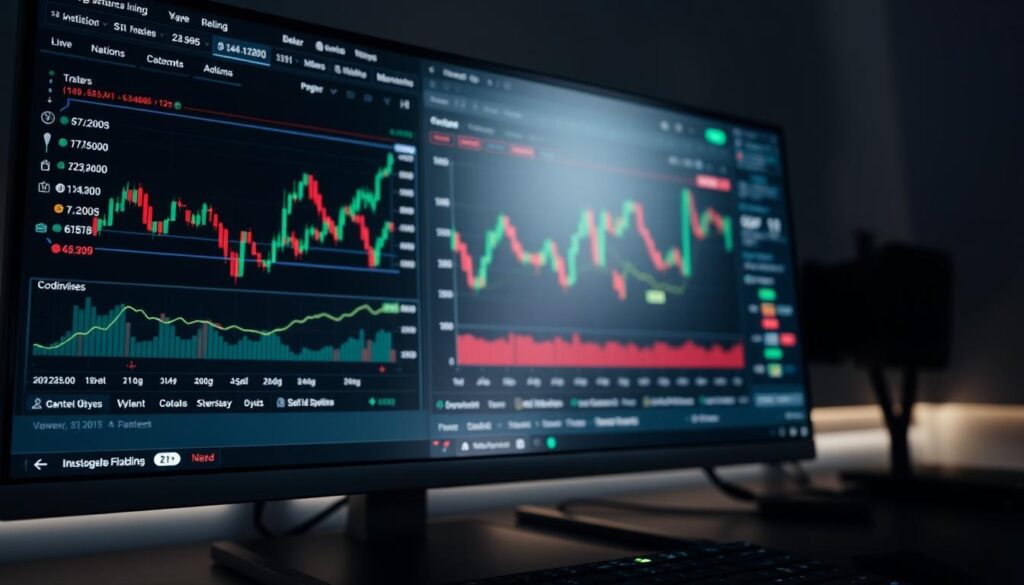Now Reading: Discover Arbitrage Opportunities Crypto Market Analysis for Profitable Trades
- 01
Discover Arbitrage Opportunities Crypto Market Analysis for Profitable Trades
Discover Arbitrage Opportunities Crypto Market Analysis for Profitable Trades

Welcome to your guide on a unique trading method. This approach lets you profit from small price differences for the same digital asset. These differences appear across various trading platforms.
This strategy is often considered lower-risk. You buy an asset on one exchange where the price is low. Then, you quickly sell it on another where the price is higher. The profit comes from the gap between the two prices.
Why do these gaps exist? The digital asset world is decentralized. Supply and demand can vary greatly from one platform to the next. Some exchanges have high liquidity, while others have less. This creates temporary imbalances that savvy individuals can use.
Success relies on swift and effective evaluation. You must identify these situations before the prices equalize. This introduction lays the groundwork for understanding the tools and techniques needed.
Key Takeaways
- This strategy profits from price differences for the same asset on different platforms.
- It is generally viewed as a lower-risk approach to digital asset trading.
- Price gaps occur due to the decentralized nature of the asset class and varying liquidity.
- Speed and careful evaluation are critical for capitalizing on these situations.
- The guide will cover essential strategies and risk management for newcomers and experienced individuals.
Introduction to Crypto Arbitrage Trading
Navigating the world of digital assets reveals a fascinating strategy for generating returns. This method focuses on exploiting temporary imbalances across various platforms.
What Is Crypto Arbitrage?
This technique involves buying a digital asset on one platform and simultaneously selling it on another. The profit comes from the gap between the purchase and sale prices.
For instance, if Bitcoin is listed at $50,000 on Exchange A and $50,200 on Exchange B, a trader can capitalize on the $200 difference. This works because each trading venue operates independently.
Why Arbitrage Trading Matters Today
The digital asset landscape is vast, with over 750 global platforms. This fragmentation creates a constant stream of potential situations for alert individuals.
Speed is essential. These price gaps often close quickly as others identify them. Understanding why they occur is the first step to success.
Key reasons for price differences include:
| Factor | Description | Impact on Price |
|---|---|---|
| Liquidity Variation | Some platforms have higher trading volume than others. | Lower liquidity can lead to larger price swings. |
| Regional Demand | Interest in an asset can differ by geographic location. | Creates distinct supply and demand on local exchanges. |
| Platform Dynamics | Each exchange has unique fees, rules, and user bases. | Directly influences the final trading price for users. |
Understanding Arbitrage Opportunities Crypto Market Analysis
Real-time assessment of digital asset values across multiple venues forms the foundation of profitable trading approaches. Traders systematically scan various platforms to spot pricing gaps that can yield returns.
The digital asset space operates continuously without breaks. This creates a stream of potential situations that appear and vanish rapidly. Effective evaluation demands constant attention to price movements.

Many participants use automated systems to monitor numerous platforms simultaneously. These tools can execute transactions within seconds when favorable conditions emerge. Speed is essential in this fast-paced environment.
Price volatility actually benefits this approach. Larger swings create more significant disparities between trading venues. These differences can translate into profitable transactions for alert individuals.
With over 750 global platforms available, each operates with unique supply and demand dynamics. This fragmentation ensures a steady supply of pricing variations. Each exchange reflects its own user base and liquidity conditions.
Successful implementation requires careful cost calculation. The spread between prices must exceed all transaction expenses. These include platform fees, network costs, and potential execution variances.
Specialized tools provide real-time data feeds for immediate decision-making. Timing is critical since favorable conditions may last only moments. Proper analysis helps capture value before markets adjust.
Exploring Types of Crypto Arbitrage Strategies
Multiple strategic approaches help traders profit from value disparities in the digital space. Each method has unique characteristics and execution requirements.
Cross-Exchange and Spatial Arbitrage
The simplest form involves buying digital assets on one platform and selling on another. This basic approach requires exceptional speed as price gaps close quickly.
Spatial variations take advantage of regional price differences. These can occur between countries with different supply and demand dynamics. However, regulatory restrictions often complicate execution.
Triangular and Decentralized Arbitrage
Triangular methods exploit inconsistencies between three trading pairs on the same platform. This advanced strategy requires identifying exchange rate inefficiencies quickly.
Decentralized approaches involve trading between different exchange types. Automated market makers on decentralized platforms can create pricing differences compared to traditional order books.
Each trading style offers distinct advantages for different skill levels. Understanding these options helps participants choose methods matching their capabilities.
Advanced Techniques: Flash Loans and Automated Trading
Sophisticated financial instruments have emerged that transform how traders approach price discrepancies. These advanced methods leverage cutting-edge technology to capture value with unprecedented speed.
Leveraging Flash Loan Arbitrage
Flash loans represent a revolutionary development in decentralized finance. Traders can borrow substantial amounts without collateral requirements.
The entire process occurs within a single blockchain transaction. Funds are borrowed, used for profitable transactions, and repaid instantly. This approach demands deep technical knowledge of smart contracts.

Utilizing Bots and Automated Tools
Automated systems have become essential for successful crypto arbitrage trading. These programs monitor multiple exchanges simultaneously.
Bots identify pricing gaps and execute trades within seconds. They operate continuously without human intervention. This ensures no profitable situation is missed.
Proper setup requires understanding trading algorithms and fee structures. While powerful, these tools need ongoing monitoring for optimal performance.
Analyzing Market Inefficiencies and Price Discrepancies
Price inconsistencies between exchanges represent more than just random fluctuations—they reveal underlying market dynamics. These variations occur systematically across trading platforms due to several key factors.

Factors Influencing Pricing Differences
Liquidity levels significantly impact asset valuation across platforms. Exchanges with higher trading volumes typically update prices more rapidly than smaller venues.
Supply and demand dynamics vary between trading platforms based on their user base and geographic location. Regional preferences create distinct valuation patterns for digital assets.
The decentralized nature of digital asset trading contributes to persistent inefficiencies. Over 750 independent platforms operate without centralized price coordination.
Information asymmetry between exchanges also plays a crucial role. Not all platforms have equal access to real-time data or order flow information.
New coins and trading venues introduce additional irregularities. Varying adoption rates and listing timing create temporary windows for profitable transactions.
Understanding these systematic factors helps traders identify where value gaps are most likely to occur. This knowledge forms the foundation for developing effective trading approaches.
Effective Risk Management in Arbitrage Trading
Before executing any transaction, prudent individuals establish safeguards against unexpected outcomes. Proper risk management separates successful traders from those who experience preventable losses.

Mitigating Volatility and Slippage
Market volatility represents a significant challenge for traders. Even brief delays can cause favorable conditions to disappear.
Slippage occurs when execution prices differ from expected levels. This often happens during rapid price movements. It can reduce or eliminate potential gains.
Smart traders use limit orders to control execution prices. They also maintain funds on multiple platforms. This minimizes transfer delays between exchanges.
Ensuring Liquidity and Managing Fees
Liquidity is crucial for successful trades. Low-liquidity exchanges may not handle large orders well. This can impact execution prices negatively.
Transaction costs require careful calculation. Each trade involves platform fees and network costs. These expenses must be factored into profit calculations.
Diversifying across multiple exchanges helps manage risk. Starting with smaller trade sizes allows strategy testing. Continuous fee monitoring ensures cost efficiency.
Profitability Factors: Fees, Timing, and Liquidity Considerations
Turning price differences into actual gains depends heavily on managing costs, timing, and platform selection. Each element plays a crucial role in determining whether a trade generates meaningful returns.
Transaction expenses represent the most significant barrier to profitability. Every trade involves multiple cost layers that must be calculated precisely. These include platform fees, network costs, and withdrawal charges.
Smart traders optimize their fee structures by selecting exchanges with competitive pricing. Some platforms offer discounts for users holding native tokens. Choosing networks during low-congestion periods also reduces expenses.
Timing is absolutely critical in this fast-paced environment. Profitable situations typically exist for only seconds before prices equalize. Automated tools help capture these brief windows effectively.
Liquidity directly impacts execution quality. High-volume platforms allow larger trades without price slippage. Low-liquidity venues may cause execution prices to differ from expected levels.
| Factor | Key Consideration | Profit Impact |
|---|---|---|
| Fee Management | Trading fees, withdrawal costs, network expenses | Directly reduces net gains |
| Execution Timing | Speed required before gaps close | Determines opportunity capture |
| Platform Liquidity | Volume available for large orders | Affects slippage and price stability |
Successful participants develop frameworks for calculating net profitability. They account for all variables before executing transactions. This approach helps focus efforts on genuinely profitable situations rather than apparent opportunities that disappear after costs.
Understanding these dynamics is essential for developing effective approaches. For deeper insights into market inefficiencies and profitable strategies, comprehensive analysis provides valuable guidance.
Best Tools and Platforms for Crypto Arbitrage
Modern trading platforms offer automated systems that scan multiple exchanges simultaneously for favorable conditions. These tools help users identify value differences quickly and efficiently.
Arbitrage Scanners and Trading Bots
Specialized bots monitor cryptocurrency prices across different exchanges around the clock. They execute trades within seconds when favorable situations appear.
ArbitrageScanner sources data from over 75 centralized exchanges and 20+ decentralized platforms. This service provides real-time alerts for profitable situations at $69 monthly.
Cryptohopper offers AI-powered trading bots starting around $24 per month. These systems can follow customized strategies without constant supervision.
Using Calculators and Price Alerts
Profit calculators help traders evaluate potential gains accurately. They account for all fees including trading costs and network expenses.
Alert systems notify users when significant price discrepancies emerge. Customizable thresholds ensure notifications only for worthwhile situations.
Free tools like CoinMarketCap allow manual comparison of prices across exchanges. This approach works well for learning and occasional trading activities.
Strategies for Maximizing Arbitrage Profits
The journey from occasional gains to consistent profitability involves developing disciplined execution frameworks. Successful practitioners focus on systematic approaches that transform temporary imbalances into reliable returns.
Developing a Robust Trading Strategy
Newcomers should begin with smaller transactions to minimize exposure while learning mechanics. This approach allows for strategy testing without significant financial risk.
Careful platform selection is crucial for sustainable success. Traders should evaluate cryptocurrency exchanges based on fee structures, liquidity levels, and transaction speeds. Regular strategy reviews help adapt to changing conditions.
Diversification across multiple venues reduces concentration risk. Maintaining funds on different platforms enables rapid execution when favorable situations emerge.
Insights from Real-World Case Studies
The July 2023 Curve Finance situation demonstrates how regional differences create significant profit potential. CRV traded at 600% premium on Bithumb compared to global exchanges.
South Korean platforms frequently show substantial premiums due to concentrated investor demand. Traders can take advantage of these regional price differences with proper timing.
These examples highlight the importance of market awareness and precise execution. Understanding regulatory considerations and withdrawal capabilities is essential for capitalizing on such situations.
Conclusion
Mastering this approach requires dedication and continuous learning. The fragmented nature of digital asset exchanges creates ongoing potential for alert individuals.
Success hinges on balancing multiple factors. Speed matters greatly when capitalizing on temporary value gaps. Careful cost calculation ensures profits exceed all expenses.
Newcomers should start small to build practical experience. Gradual scaling allows for strategy refinement. Proper risk controls help prevent significant losses during the learning process.
Advanced techniques like automated systems can enhance efficiency. However, human oversight remains essential for adapting to changing conditions. The landscape evolves constantly as platforms update their fee structures.
This guide provides the foundation for developing effective approaches. For those interested in expanding their toolkit, explore crypto derivatives trading as a complementary strategy. Consistent profitability comes from disciplined execution and ongoing education.
FAQ
What is the basic principle behind cryptocurrency arbitrage?
The core idea is to buy a digital asset on one platform where its price is lower and simultaneously sell it on another where the price is higher. This strategy exploits temporary pricing differences between exchanges to generate profit from the gap.
How does triangular arbitrage work within a single exchange?
This method involves trading between three different cryptocurrencies on the same platform. For example, a trader might convert Bitcoin to Ethereum, then Ethereum to Litecoin, and finally Litecoin back to Bitcoin, aiming to end up with more Bitcoin than they started with by capitalizing on mispricings between the pairs.
What are the biggest risks involved in this trading strategy?
Key risks include transaction fees eating into profits, price slippage during trade execution, and withdrawal delays between platforms. Market volatility can also erase a pricing difference before a trade is complete, leading to potential losses instead of gains.
Can automated tools like trading bots improve arbitrage success?
Yes, bots can significantly enhance efficiency. They monitor multiple exchanges in real-time, execute trades faster than humans, and help manage complex strategies like triangular arbitrage. However, they require proper configuration and understanding of their logic to be effective.
Why do price discrepancies occur across different cryptocurrency exchanges?
Variations in supply and demand on individual platforms, differences in trading volume and liquidity, and delays in information spreading across the global market all contribute to these pricing differences. Geographic factors and local regulations can also influence asset prices.
What role do flash loans play in decentralized arbitrage?
Flash loans allow traders to borrow substantial capital without collateral to execute profitable trades within a single blockchain transaction. This advanced technique is used in decentralized finance (DeFi) to capitalize on pricing gaps across various protocols, but it carries significant technical risk.
How important is liquidity when engaging in this type of trading?
High liquidity is crucial. It ensures that large orders can be filled without significantly moving the market price, which is essential for locking in profits. Trading on illiquid platforms can result in slippage, where the final execution price is worse than expected.
What tools can help identify profitable arbitrage situations?
Specialized scanners and screeners from platforms like Arbismart or Cryptohopper can track price differences across numerous exchanges. Price alert systems and profit calculators are also valuable for spotting and evaluating potential trades quickly.















